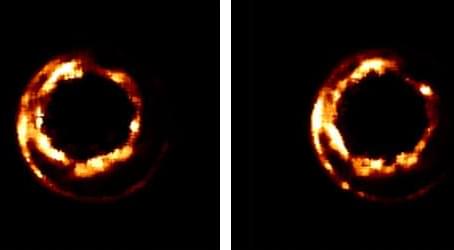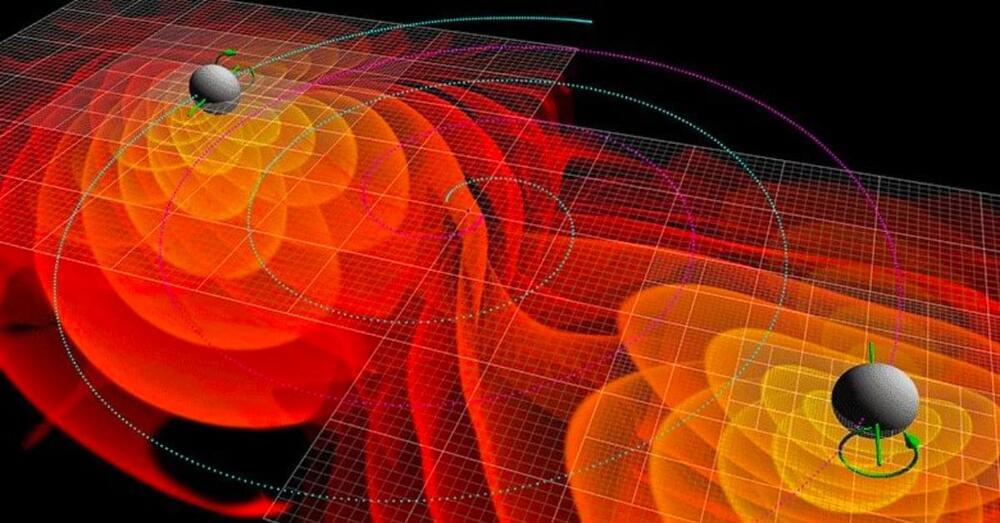A new type of plasma accelerator combines two previous methods of producing an electron beam into one compact design.




Characterized by just three parameters—mass, spin, and charge—black holes could be considered one of the Universe’s simpler astrophysical objects. Yet, the number of open problems related to how the dark behemoths behave also marks them as one of the most enigmatic. One puzzle is why the plasma around black holes glows so brightly. Now, in 3D simulations of the magnetic fields within this plasma, Benjamin Crinquand of Princeton University and colleagues think they have found the answer: the breaking and reconnecting of magnetic-field lines [1]. The simulations predict that, under certain conditions, magnetic-field instabilities can induce radio-wave hot spots that rotate around the shadow of the black hole. This prediction could be tested by future versions of the Event Horizon Telescope (EHT)—the network of radio dishes used to capture the first black hole images (see Research News: First Image of the Milky Way’s Black Hole).
There are several mechanisms that physicists think could be behind a black hole’s light. One of those is so-called accretion power, where friction-like forces in the infalling plasma heat the plasma, leading to the emission of photons. Models of this process predict constant emission signals, which doesn’t seem to fit with observations of high-intensity bursts of gamma rays from black holes.
Another possibility—and the one that Crinquand and his colleagues consider—is that the energy needed to create this light is extracted from the magnetic field that threads through the plasma. When the lines associated with this field break apart and then reconnect—a process known as magnetic reconnection—magnetic-field energy can convert into plasma-kinetic energy that is then emitted as photons. This model would not replace the accretion one, but act in tandem with it.

A new study presents a new neurocomputational model of the human brain, which might shed light on how the brain develops complex cognitive skills and advance neural artificial intelligence research. An international team of scientists from the Institut Pasteur and Sorbonne University in Paris, the CHU Sainte-Justine, Mila – Quebec Artificial Intelligence Institute, and the University of Montreal conducted the study.

One of Stephen Hawking’s most famous theories has been confirmed to be correct, thanks to space-time ripples caused by the merger of the two distant black holes.
The black hole area theorem, which Hawking derived from Einstein’s theory of general relativity in 1971, states that the surface area of a black hole cannot decrease over time. This rule is of importance to physicists because it appears to set time to run in a certain direction: the second law of thermodynamics, which states that the entropy, or disorder, of a closed system must always rise. Because the entropy of a black hole is proportional to its surface area, both must always increase.
The researchers’ confirmation of the area law, according to the new study, appears to suggest that the properties of black holes are crucial hints to the hidden laws that control the universe. Surprisingly, the area law appears to contradict another of the famous physicist’s proven theorems: that black holes should evaporate over incredibly long time scales, suggesting that determining the source of the conflict between the two theories might reveal new physics.

Diehard Elon Musk fans have created a 30-foot-long monument dedicated to their hero – and it cost them over half a million pounds ($600,000).
The unique piece sees the richest man in the world’s head attached to a goat’s body while riding a rocket.
It’s the brainchild of cryptocurrency firm Elon GOAT Token ($EGT), who later this month plan to present it to the billionaire at his Tesla workplace in Austin, Texas.

Flying car startup Airspeeder has completed what it’s referring to as the “world’s first electric flying car race” in the South Australian desert.
While the two competing pilots were steering the two full-scale flying cars remotely, it still made for an epic launch of a brand new kind of motorsport, as seen in a promotional video of the event.
“This is just the start, this first race offers only a glimpse of our promise to deliver the most progressive, transformative and exciting motorsport in the world,” Airspeeder founder Matt Pearson said in a press release.


To design better rechargeable ion batteries, engineers and chemists from the University of Illinois Urbana-Champaign collaborated to combine a powerful new electron microscopy technique and data mining to visually pinpoint areas of chemical and physical alteration within ion batteries.
A study led by materials science and engineering professors Qian Chen and Jian-Min Zuo is the first to map out altered domains inside rechargeable ion batteries at the nanoscale—a 10-fold or more increase in resolution over current X-ray and optical methods.
The findings are published in the journal Nature Materials.